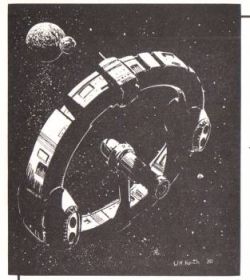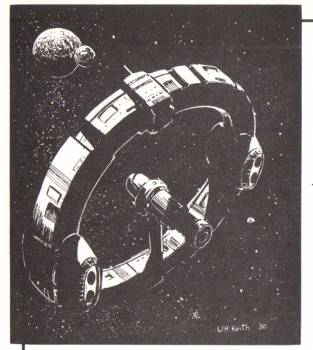Type L class Laboratory Ship
| Type L class Laboratory ship | |
|---|---|
 TBD | |
| Type: L Research Ship | |
| Size | 400 Tons |
| Hull Configuration | [[Ring Hull]] |
| Streamlining | Unstreamlined Hull |
| Tech Level | TL–11 |
| Engineering | |
| Computer | Model/2 computer |
| Jump | J-2 |
| Maneuver | 1 G |
| Armaments | |
| Hardpoints | 2 |
| Accommodations | |
| Staterooms | 0 |
| Personnel | |
| Crew | 5: Pilot, Navigator, Medic, two Engineers, additional scientific crew 20 |
| Officers | 5 |
| High/Mid Passengers | 0 |
| Payload | |
| Cargo | 23 Tons |
| Fuel tank | 0 Tons |
| Construction | |
| Origin | Third Imperium |
| Price | |
| Cost | MCr158.9841 |
| Architect fee | MCrCanon publication design. |
| Statistics | |
| Quick Ship Profile | L-DC12 |
| Images | |
| Blueprint | Yes |
| Illustration | Yes |
| Source | |
| Canon | Published, fan design |
| Era | 1105 |
| Reference | Argon Gambit/Death Station TBD. |
| Starships are designed with the Classic Traveller format, using High Guard. | |
The Type L class Laboratory Ship is a civilian research starship.
- The standard research ship, of which dozens of models, varieties, and classes are used throughout Charted Space.
- Larger or smaller science ships are available, but the Type L remains the mostly popular ship for this sort of mission.
- It is an ordinarily unarmed civilian ship and is classified as a Laboratory Ship.
Basic Ship Synopsis
L Laboratory Ship. 400 tons. Jump-2. 1-G. 90 tons fuel. Model/2. 20 staterooms. 2 hardpoints. Air/rafts, 1 Pinnace. 23 tons cargo. 85 tons lab space. Unstreamlined. 5 crew. MCr158.98: 14 months. [1]
Description (Specifications)
The lab ship is built as a ring structure which is rotated to provide centrifugal gravity simulation. Although the standard grav plates and inertial compensators are installed, they may be turned off and centrifugal force used instead. Two drive pods are mounted on the rings and contain drives and the power plant.
Image Repository
Basic Ship Characteristics
Following the Imperial Navy and IISS Universal Ship Profile and data, additional information is presented in the format shown here. The small craft factor indicates the number of squadrons (of ten craft) carried on the ship. Tonnage on the universal ship profile is shown in kilotons (thousands of tons) where necessary. [2]
| #. | Category | Remarks |
|---|---|---|
| 1. | Tonnage | 400 tons. The ship is unstreamlined. |
| 2. | Crew | The lab ship requires a crew of five: pilot, navigator, medic, and two engineers. The pilot also operates the pinnace. Gunners may be added to the crew if the ship is armed. Additional crew are carried to execute the research functions. |
| 3. | Performance | It has jump drive-D, maneuver drive-C, and power plant-F, giving the ship a performance of Jump-2 and 1-G acceleration. There is fuel tankage for 90 tons, sufficient to supply the power plant and one Jump-2. |
| 4. | Electronics | A computer Model/2 with software package is installed adjacent to the bridge. |
| 5. | Hardpoints | x2 hardpoints (x4 possible). On the forward face of the pods are hardpoints for the turret weaponry if called for. |
| 6. | Armament | No turrets or weaponry are installed, but two tons of space have been reserved for later installation of fire control equipment for the ship's two hardpoints. |
| 7. | Defenses | There are no standard defenses equipped. |
| 8. | Craft | The ship carries one 40-ton pinnace and two air/rafts. Two air/rafts are carried in compartments on the ring hull. They provide access to world surfaces, both for specimen gathering and for routine errands. The 40-ton pinnace is carried at the end of a central spoke, making mating easy even if the ring is rotating. |
| 9. | Fuel Treatment | Refueling: Since the lab ship is unstreamlined, and cannot skim fuel itself, this task falls to the 40-ton pinnace. It is assigned the routine of skimming fuel from a gas giant and ferrying it to the ship. On worlds with refined fuel available, the pinnace ferries the fuel from the starport to the lab ship. |
| 10. | Cost | The ship costs MCr158.9841. |
| 11. | Construction Time | It takes 16 months to construct. |
| 12. | Comments | There are twenty staterooms and no low berths. Cargo capacity is 23 tons. An additional 85 tons are available within the ship for use as lab space. |
History & Background (Dossier)
Operations: Typically, a lab ship will be purchased (or chartered) and assigned to a specific system or world for a series of research projects. After jumping to the system, the ship takes up orbit and begins its regimen of experiments. Lab ships are capable of moving great distances, but generally take up station and remain in one place for long periods of time. The air/rafts are used for routine transport while the pinnace is used for heavier work or missions requiring greater speed. The ship itself has minor thrusters positioned along the ring allowing for rotation as desired.
Class Naming Practice/s & Peculiarities
No information yet available.
Selected Variant Types & Classes
Some of the best known and most widely produced versions of this ship include:
Civilian Ship - Scientific Vessel - Laboratory Ship:
References & Contributors (Sources)
| This article has metadata. |
- Frank Chadwick, Marc Miller. Argon Gambit/Death Station (Game Designers Workshop, 1981), TBD.
- Marc Miller. Starter Traveller (Game Designers Workshop, 1983), 11.
- Anonymous. SGS: Lab Ship (Seeker Gaming Systems, 1991), TBD.
- Loren Wiseman. Challenge 71 (Game Designers Workshop, 1993), TBD.
- Frank Chadwick, Dave Nilsen. "Technical Booklet." Brilliant Lances (1994): 24.
- Martin Dougherty. Theories of Everything (Mongoose Publishing, 2016), TBD.
- Marc Miller. T5 Core Rules (Far Future Enterprises, 2013), TBD.
- Traveller Wiki Editorial Team
- Author & Contributor: Lord (Marquis) and Master of Sophontology Maksim-Smelchak of the Ministry of Science
- ↑ Marc Miller. Starter Traveller (Game Designers Workshop, 1983), 11.
- ↑ Timothy B. Brown. Fighting Ships (Game Designers Workshop, 1981), 10.
- ↑ Timothy B. Brown. Fighting Ships (Game Designers Workshop, 1981), 10.
